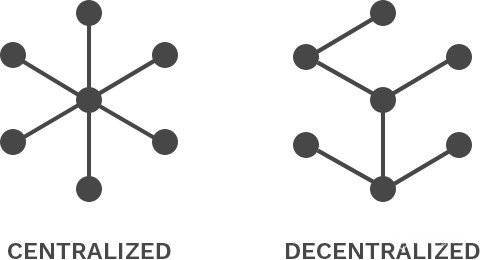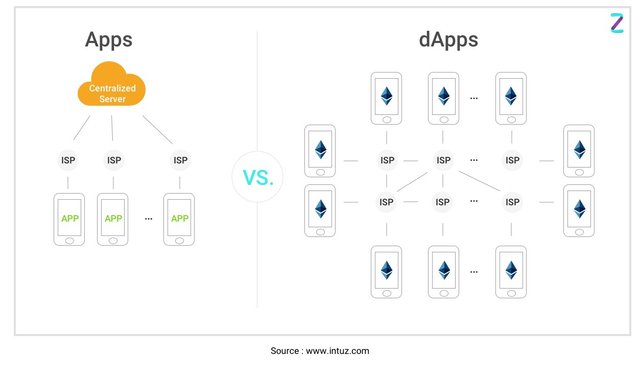
Hello Everyone........
Its my first class with @yohan2on and its seems very interesting it will help me to know about new technologies. I got a chance to learn new things in detail. I am very thankful to our professor Mr. @yohan2on who created a learning environment for us that can help everyone in learning and gaining knowledge.
Comparing and Contrasting between Centralized and Decentralized Apps
As you people already know about centralized and decentralized apps. Here I define a little bit about centralized and decentralized apps. most of people are familiar with the term Apps as it pre-trains to the software.
What are Decentralized Applications
A software application is defined to perform specific goals. The difference between centralized and decentralized app is that once decentralized apps are developed cannot be shutdown by any one, if we use this definition there is no single app that can be considered as completely decentralized Ethereum claims to be DAPP (decentralized application) but if we apply the earlier definition to any ethereum application thay cannot be consider as fully DAPPs because the mere fact that the backend logic and the actual server running these apps are controlled by third party. A decentralized apps distributes work load among several machines. instead of relying on single server.

What is Centralized Applications?
A centralized applications are connected to a single main server that perform all other major processing and less powerful workstations are connected to a server and submit there requests to central server than performing them directly. An example of centralized app is Facebook while an example of partially decentralized partially centralized app is cryptokitties where the logic of the app is coded in the form of smart contracts in the Ethereum blockchain while the running of the apps is being done in a centralized server that is owned by the Cryptokitties developers.
Comparison Between Decentralized app and Centralized apps
Centralized Applications
No central point of failure:
Comparing to centralised applications, dApps are more reliable, because they use the advantages of a decentralised network. A dApp stores data in a decentralised database and uses decentralised computing resources to work.
Open source code:
Decentralised architecture presumes that application source code can be accessible by all network members. In a trustless environment, the user needs to be able to verify what kind of application he is running and what exactly it does.
Decentralised consensus mechanism
when the app is working in a decentralised environment, where all users have equal rights to change the data, there has to be a way for all network peers to agree on which data and transactions to trust. The solution to this problem is called a consensus mechanism.
Usage of internal currency
There are many reasons for a dApp to use some form of currency: to support the development process, to fuel the underlying network and its consensus mechanism, to give the users a way to exchange value, and many others. It creates a healthy economic system around the app and helps the project grow.
Decentralized Applications
A dApp is not the synonym of the blockchain, it all started with peer-to-peer networks. But the blockchain technology empowers dApps to create a sustainable economic system and offers state-of-the-art consensus mechanisms proven by many adopters. Let’s have an overview of the history of dApps and review the most popular platforms for dApp creation.
Peer-to-peer networks
The rise of the decentralised networks began with peer-to-peer content delivery and media sharing protocols like Gnutella, eDonkey and BitTorrent. These protocols helped users to download the content faster because they could connect to multiple peers and have many channels instead of one centralised storage server. Media sharing networks also helped to get licensed media content for free, and some consider it the main reason for the successful adoption and popularity of the technology.
PopcornTime
An example of a dApp built on top of the BitTorrent protocol is PopcornTime — an app used to stream video content from BitTorrent — like Netflix, but decentralised. PopcornTime is open source, has no central point of failure, but doesn’t use an internal currency. Although the nodes in BitTorrent are incentivised for sharing the content they downloaded by faster download speed, so no formal currency is used.
OpenBazaar
Another dApp that started running on top of the BitTorrent is OpenBazaar. OpenBazaar is a decentralised marketplace with bitcoin and other major cryptocurrencies used for payment. It acts as the Ebay in the decentralised world. This dApp is trustless, free for use, has no censorship, so no entity can control the participants and dictate what they buy and sell and for how much. OpenBazaar is open source and started from a hackathon project called DarkMarket. At early stages, BitTorrent was used to host a shop, but later the project moved to IPFS to store the data. So now OpenBazaar has all the technologies to prevent a single point of failure and rightfully belongs to the decentralised universe.
Advantagees of Decentralized Apps:
- Payment processing does not require a third-party financial operator. In a decentralized network, transactions between users are performed directly and in cryptocurrency.
- There is no need for registration or subscription due to the use of public and private keys for accessing data.
- Open source and public registry make sure the platform is transparent and easy to use.
Advantages of Centralized System
Easy to physically secure. It is easy to secure and service the server and client nodes by virtue of their location
Smooth and elegant personal experience – A client has a dedicated system which he uses(for example, a personal computer) and the company has a similar system which can be modified to suit custom needs
Dedicated resources (memory, CPU cores, etc)
More cost efficient for small systems upto a certain limit – As the central systems take less funds to set up, they have an edge when small systems have to be built
Quick updates are possible – Only one machine to update.
Easy detachment of a node from the system. Just remove the connection of the client node from the server and voila! Node detached.
Disadvantages of Centralized System
Highly dependent on the network connectivity – System can fail if the nodes lose connectivity as there is only one central node.
No graceful degradation of system – abrupt failure of the entire system
Less possibility of data backup. If the server node fails and there is no backup, you lose the data straight away
Difficult server maintenance – There is only one server node and due to availability reasons, it is inefficient and unprofessional to take the server down for maintenance. So, updates have to be done on-the-fly(hot updates) which is difficult and the system could break.
Advantages of Decentralized System
Minimal problem of performance bottlenecks occurring – The entire load gets balanced on all the nodes; leading to minimal to no bottleneck situations
High availability – Some nodes(computers, mobiles, servers) are always available/online for work, leading to high availability
More autonomy and control over resources – As each node controls its own behavior, it has better autonomy leading to more control over resources.

Hello @osamaparacha.
Thanks for attending the lecture and doing your homework.
Unfortunately, most of your work is just copied and pasted.
Plagiarism is highly prohibited on steemit.
Downvoting a post can decrease pending rewards and make it less visible. Common reasons:
Submit